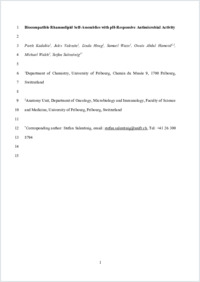Biocompatible Rhamnolipid Self‐Assemblies with pH‐Responsive Antimicrobial Activity
DOKPE
- Kadakia, Parth University of Fribourg
- Valentin, Jules University of Fribourg
- Hong, Linda University of Fribourg
- Watts, Samuel University of Fribourg
- Abdul Hameed, Owais University of Fribourg
- Walch, Michael University of Fribourg
- Salentinig, Stefan ORCID University of Fribourg
- 2023
Published in:
- Advanced Healthcare Materials. - Hoboken, New Jersey, USA : Wiley. - 2023
English
There is an urgent need for alternative antimicrobial materials due to the growing challenge of bacteria becoming resistant to conventional antibiotics. This study demonstrates the creation of a biocompatible pH-switchable antimicrobial material by combining bacteria-derived rhamnolipids (RL) and food-grade glycerol monooleate (GMO). The integration of RL into dispersed GMO particles, with an inverse-type liquid crystalline cubic structure in the core, leads to colloidally stable supramolecular materials. The composition and pH-triggered structural transformations are studied with small-angle X-ray scattering, cryogenic transmission electron microscopy, and dynamic light scattering. The composition-structure-activity relationship is analyzed and optimized to target bacteria at acidic pH values of acute wounds. The new RL/GMO dispersions reduce Staphylococcus aureus (S. aureus) populations by 7-log after 24 h of treatment with 64 µg mL−1 of RL and prevent biofilm formation at pH = 5.0, but have no activity at pH = 7.0. Additionally, the system is active against methicillin-resistant S. aureus (MRSA) with minimum inhibitory concentration of 128 µg mL−1 at pH 5.0. No activity is found against several Gram-negative bacteria at pH 5.0 and 7.0. The results provide a fundamental understanding of lipid self-assembly and the design of lipid-based biomaterials, which can further guide the development of alternative bio-based solutions to combat bacteria.
- Faculty
- Faculté des sciences et de médecine
- Department
- Département de Chimie
- Language
-
- English
- Classification
- Chemistry
- License
-
Rights reserved
- Open access status
- green
- Identifiers
-
- DOI 10.1002/adhm.202302596
- ISSN 2192-2640
- ISSN 2192-2659
- Persistent URL
- https://folia.unifr.ch/unifr/documents/327747
Statistics
Document views: 78
File downloads:
- biocompatiblerhamnolipidantimicrobialsfolia: 96
